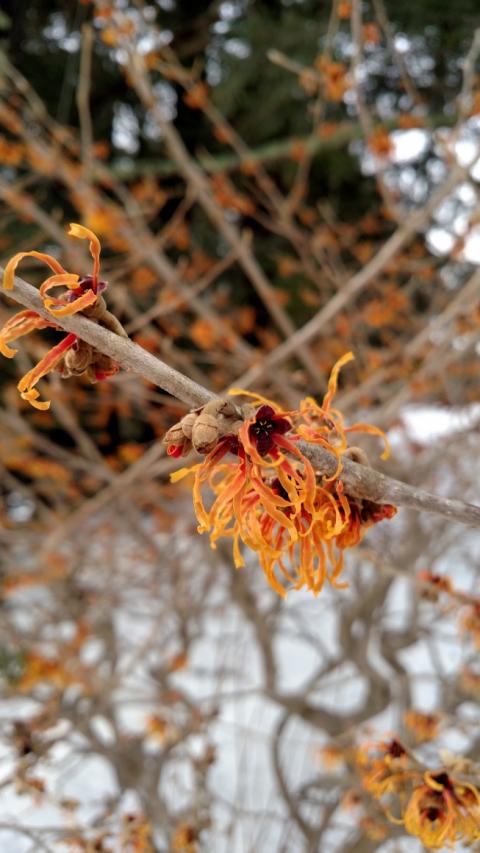Which Witchhazel

In recent years there has been growing excitement around creating “winter interest” in the garden, and for good reason! Perennial gardens have the potential to be ornamental year-round. Many gardeners design their landscapes with winter interest specifically in mind, choosing plants with showy bark, brightly colored stems, evergreen foliage and persistent berries. Even an uncut clump of ornamental grass can be an interesting feature in the winter landscape, especially when the wind plays through the stems. Yet, the winter garden does not need to be devoid of flowers. Many witchhazels are at their very best this time of year.
Most witchhazels bloom in the winter months, from February to March, and produce fragrant and spidery flowers with crinkled, strap-like petals. Depending on species and cultivar, the flower color ranges the full spectrum between pale yellow and red. Witchhazels may be best known for their use in first aid and skin care products, but these shrubs have a lot to offer in the garden. Most species boast vibrant fall foliage as well as late winter blooms. If you don’t have a witchhazel of your own in the garden, look for it in the landscape this month.
Asian and hybrid witchhazels
There are two species of Asian witchhazel that bloom in the winter months. Chinese witchhazel (Hamamelis mollis) is the more ornamental of the two, with abundant yellow flowers that are extremely fragrant. Japanese witchhazel (Hamamelis japonica) is far less common in the landscape but is one of the parent plants of the popular hybrid Hamamelis x intermedia – a cross between Chinese and Japanese witchhazel. H. x intermedia flowers from February to March depending on cultivar. It is an upright-spreading or vase shaped shrub that can grow 15’ to 20’ tall and wide. These plants are hardy to Zone 5, although extreme cold can damage buds.
Don’t forget the natives!
There are two species of witchhazel native to North America. Vernal witchhazel (Hamamelis vernalis) grows wild in the southern and central United States along moist stream banks. Although not quite as showy as H. x intermedia, this hardy plant can survive to Zone 4 and produces vibrant flowers starting in February. There are a variety of cultivars available with flower colors varying from yellow to red.
Our New Hampshire native, common witchhazel (Hamamelis virginiana), is no less deserving of a place in the garden, although it blooms in late fall.
Looking to plant witchhazel? Try one of these plants:
- H. x intermedia ‘Arnold Promise’ is a tried and true cultivar introduced by the Arnold Arboretum. This plant blooms later in February and March with bright yellow and highly fragrant flowers.
- H. x intermedia ‘Diane’ blooms earlier than other cultivars with red flowers that age to copper.
- H. x intermedia ‘Jelena’ features fragrant, coppery flowers and a horizontal growth habit.
- H. x intermedia ‘Ruby Glow’ has bronze/red flowers and an upright form.
- H. mollis ‘Pallida’ has pale yellow flowers that are extremely fragrant. It blooms as early as January and February.
- H. mollis ‘Wisley Supreme’ has a spreading habit with large, fragrant and yellow flowers.
- H. vernalis grows 6’ to 10’ in height and width and is hardy to zone 4. It features peachy orange flowers.
- H. vernalis ‘Amethyst’ has purple/red flowers with crinkled petals.
In the wild, witchhazels are woodland species that are often found growing in forest edges and meadows. As a result, they will perform well in the garden whether they are planted in full sun or partial shade, although they tend to flower best when planted in full sun. Witchhazels are large, multi-stemmed shrubs that can grow anywhere from 10’ to 20’ high with an equal spread. Growth habit is quite variable between species and cultivars, ranging from upright vase-shaped to broad-spreading. In the garden, witchhazels can be planted singly as specimens or in groups as a screen or hedge.
Witchhazels are very low maintenance with few pest and disease issues. When planted in average, well-drained soils, they are the type of shrub gardeners can ignore and yet still be rewarded with showy fall foliage and late winter blooms.
Although February may seem like a bleak time in the garden, do your best to enjoy what the winter landscape has to offer, and don’t forget to stop and smell the witchhazels!